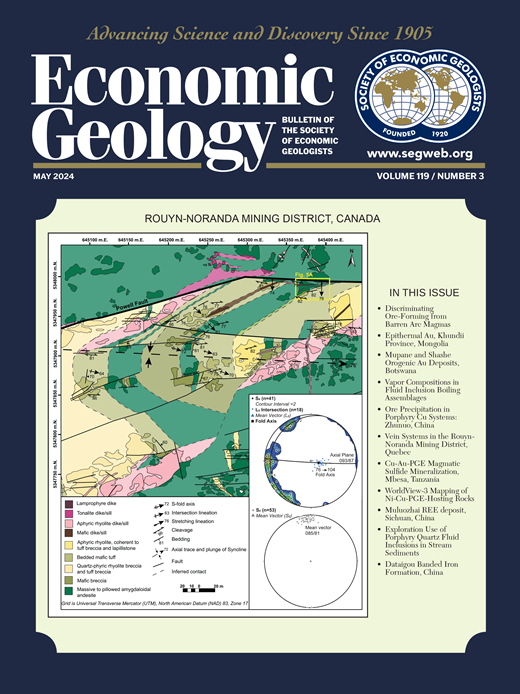Metallogenic Setting and Temporal Evolution of Porphyry Cu-Mo Mineralization and Alteration in the Delamerian Orogen, South Australia: Insights From Zircon U-Pb, Molybdenite Re-Os, and In Situ White Mica Rb-Sr Geochronology
IF 4.9
1区 地球科学
Q1 GEOCHEMISTRY & GEOPHYSICS
引用次数: 0
Abstract
Paleozoic porphyry-style hydrothermal alteration and mineralization has previously been recognized within the Delamerian orogen, South Australia, where porphyry prospects include Anabama Hill, Netley Hill, and Bendigo. However, limited exploration due in part to thick postmineralization cover hinders the understanding of the temporal context, metallogenic setting, and mineral potential of the porphyry systems along the Proterozoic continental margin of Australia. In this study, we have characterized the hydrothermal alteration and mineralization of these porphyry occurrences. Zircon U-Pb, molybdenite Re-Os, and white mica Rb-Sr ages have been determined to constrain the timing for emplacement of magmatic intrusions, precipitation of metal-bearing sulfides, and duration of hydrothermal alteration in the Delamerian orogenic belt. Zircon U-Pb laser ablation-inductively coupled plasma-mass spectrometry (LA-ICP-MS) analyses of nine granitoids reveal that the intrusive rocks were emplaced mostly between 485 and 465 Ma, whereas three intrusions at Bendigo have zircon U-Pb ages of 490 to 480 Ma. Molybdenite isotope dilution-negative thermal ion mass spectrometry (ID-NTIMS) Re-Os dating of the four prospects identifies two porphyry Cu-Mo mineralization events at 480 and 470 to 460 Ma, respectively. Nineteen white mica Rb-Sr LA-ICP-MS/MS (tandem mass spectrometers) analyses return an age range between 455 and 435 Ma for phyllic alteration at the Anabama Hill and Netley Hill prospects, whereas intense white mica-quartz-pyrite alteration at Bendigo prospect appears to have developed between 470 and 460 Ma. These geochronologic results indicate that the Delamerian porphyry systems postdated subduction-related magmatism in the region (514–490 Ma) but instead formed within an inverted back-arc regime, where mineralized magmas and fluids ascended along favorable lithospheric-scale structures, probably due to asthenospheric upwelling triggered by mafic delamination. Porphyritic stocks, dikes, and aplites with ages of 470 to 460 Ma are the most likely hosts to porphyry-style mineralization in the Delamerian orogen that appears to have formed simultaneously with the oldest known porphyry systems in the intraoceanic Macquarie arc (e.g., Marsden, E43, and Milly Milly; 467–455 Ma). These results emphasize the significance and potential of Early-Middle Ordovician intrusive systems to host such a type of magmatic-hydrothermal mineralization in the Delamerian orogen.南澳Delamerian造山带斑岩Cu-Mo矿化与蚀变的成矿背景与时间演化——来自锆石U-Pb、辉钼矿Re-Os和原地白云母Rb-Sr年代学的启示
古生代斑岩型热液蚀变和成矿作用已在南澳大利亚的Delamerian造山带被发现,斑岩远景包括Anabama Hill、Netley Hill和Bendigo。然而,由于较厚的成矿后覆盖,勘探有限,阻碍了对澳大利亚元古代大陆边缘斑岩系统的时间背景、成矿背景和矿物潜力的理解。在本研究中,我们描述了这些斑岩矿床的热液蚀变和矿化特征。确定了锆石U-Pb、辉钼矿Re-Os和白云母Rb-Sr年龄,以限制岩浆侵入岩体的侵位时间、含金属硫化物的沉淀和热液蚀变的持续时间。锆石U-Pb激光烧蚀-电感耦合等离子体质谱(LA-ICP-MS)分析表明,9个花岗岩类侵入岩的锆石U-Pb年龄大多在485 ~ 465 Ma之间,而本迪戈3个侵入岩的锆石U-Pb年龄在490 ~ 480 Ma之间。四个远景区辉钼矿同位素稀释-负热离子质谱(ID-NTIMS) Re-Os测年分别确定了480和470 ~ 460 Ma的斑岩铜钼矿化事件。19个白云母Rb-Sr LA-ICP-MS/MS(串联质谱)分析结果显示,Anabama Hill和Netley Hill勘探区的物性蚀变年龄范围在455 ~ 435 Ma之间,而Bendigo勘探区的强烈白云母-石英-黄铁矿蚀变发生在470 ~ 460 Ma之间。这些地质年代学结果表明,德拉美洲斑岩体系晚于该地区俯冲相关岩浆活动(514-490 Ma),而是形成于一个反向弧后体系,在该体系中,矿化岩浆和流体沿着有利的岩石圈尺度构造上升,这可能是由于基性剥离引发的软流圈上升流所致。年龄为470 ~ 460 Ma的斑岩岩脉、岩脉和斑岩最有可能是德拉美拉造山带斑岩型成矿的宿主,它似乎与洋内麦夸里弧中已知最古老的斑岩体系(如Marsden、E43和Milly Milly)同时形成;467 - 455 Ma)。这些结果强调了早-中奥陶世侵入体系在德拉美洲造山带孕育此类岩浆-热液成矿作用的重要性和潜力。
本文章由计算机程序翻译,如有差异,请以英文原文为准。
求助全文
约1分钟内获得全文
求助全文
来源期刊

Economic Geology
地学-地球化学与地球物理
CiteScore
10.00
自引率
6.90%
发文量
120
审稿时长
6 months
期刊介绍:
The journal, now published semi-quarterly, was first published in 1905 by the Economic Geology Publishing Company (PUBCO), a not-for-profit company established for the purpose of publishing a periodical devoted to economic geology. On the founding of SEG in 1920, a cooperative arrangement between PUBCO and SEG made the journal the official organ of the Society, and PUBCO agreed to carry the Society''s name on the front cover under the heading "Bulletin of the Society of Economic Geologists". PUBCO and SEG continued to operate as cooperating but separate entities until 2001, when the Board of Directors of PUBCO and the Council of SEG, by unanimous consent, approved a formal agreement of merger. The former activities of the PUBCO Board of Directors are now carried out by a Publications Board, a new self-governing unit within SEG.
 求助内容:
求助内容: 应助结果提醒方式:
应助结果提醒方式:


